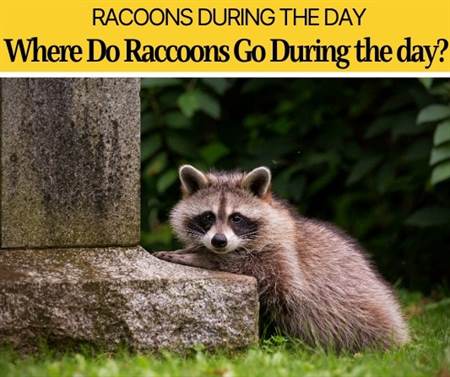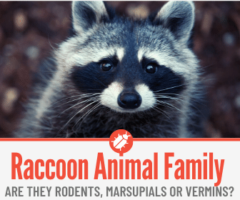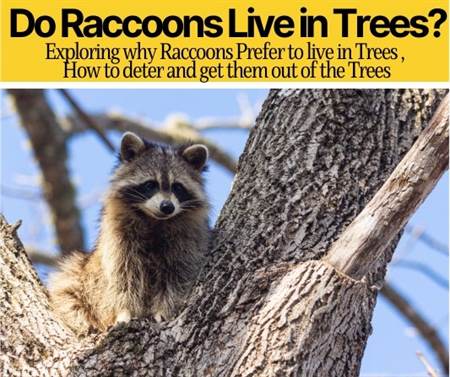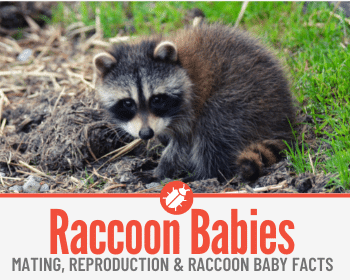 While we know much about an adult raccoon’s look and behavior, we may not know much about baby raccoons.
While we know much about an adult raccoon’s look and behavior, we may not know much about baby raccoons.
In this guide you will learn:
- When Are Baby Raccoons Born & What do they look like,
- How Fast Do Baby Raccoons grow and how to tell the age of them,
- When is Raccoon Mating Season & How to tell If a Raccoon is Pregnant,
- Where to Raccoons make dens ,gestation period & how many Babies do Raccoons have.
What are Baby Raccoons Called?
Baby raccoons are called kits or cubs. Scientists tend to use the term “kits” more frequently, but both terms are widely used.
What does a Baby Raccoon Look Like?
It is interesting to note that newborn raccoons and baby raccoons don’t look similar at all.
Newborn Raccoons
Newborn raccoons are very small and have a thin coat of fine, gray fur. They do not yet have the mask on their face, and their coat is all one color.
Newborns are also blind and deaf for the first three weeks.
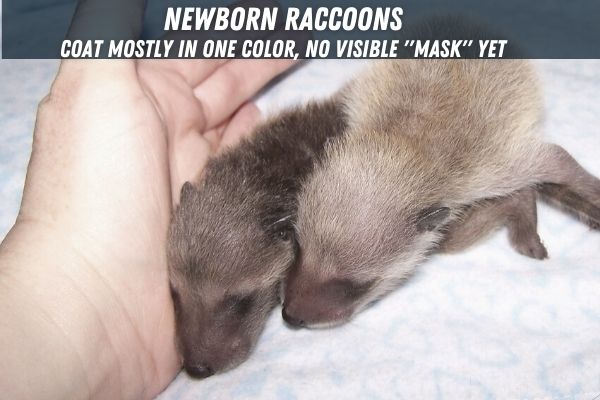
Baby Raccoons
Baby raccoons, on the other hand, begin developing thicker layers of fur as they age. Their fur color also slowly begins to change to the distinct black-and-white look of a raccoon.
When first born, baby raccoons are not nocturnal. They are most active in the day, and as they age, they slowly transition to the normal nocturnal life style of a raccoon.
Once they are about a year old, they are fully nocturnal.
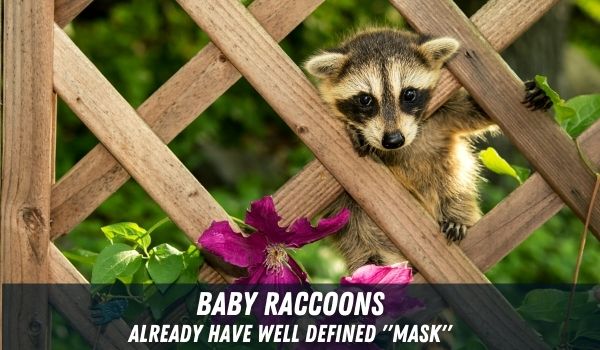
How to Tell the Age of a Baby Raccoon
If you have found a baby raccoon or are considering keeping a baby raccoon as a pet ,the best way to tell the age of a baby raccoon is its size and weight.
A few days old
At a few days old, the baby raccoon can crawl very wobbly on the ground with his legs spread apart. He is only 4.5 to 6 inches long and weighs 100 grams or less.
One week old
At one week old, the baby raccoon starts to get his pigmented tail rings, and his head will look too big for his body. Although he is still unable to walk, he will twitter and chat like a bird when hungry. At this point, he is about 7 inches long and weighs about 150 to 200 grams.
3 weeks old
At 3 weeks old, the baby raccoon is 8.5 to 10 inches long and weighs about 350 grams. Now his eyes are open, and he is extremely vocal, often hissing, growling, and snorting if disturbed.
4-5 weeks old
At 4-5 weeks old, the baby raccoon is 12 to 14 inches long and weighs about 550 grams. His ears have now opened, and he is beginning to walk.
9-12 weeks old
At 9 to 12 weeks old, the baby raccoon is 16 to 18 inches long and weighs about 950 grams. Now he is fully weaned, eating normal food, and becoming more independent of his mother. At this age, they enjoy play-fighting and imitating defense moves and postures.
5 months old
At 5 months old, the baby raccoon is a capable hunter, able to scavenge for his own food.
8-12 months old
At 8 to 12 months old, the baby raccoon is fully independent and able to leave his mother.
Related: Raccoon Diet
How long do Baby Raccoons Stay with Their Mother?
Baby raccoons live with their mother for up to a year or until they are ready to go out on their own.
The first two to three months after being born, the kits are hidden in the den. By mid-summer, they are out exploring and looking for food while still being supervised by mom.
However, they are not fully independent yet. The kits will stay with their mother for a few more months, and some even stay through their first winter.
How Long can a Baby Raccoon Survive Without its Mother?
Until they are about 8 weeks old and able to go foraging with mom, kits are very dependent on their mother for survival.
If abandoned, kits under 4 weeks will only last a day or two. Kits four to six weeks old will last a few days, but only if they can find a source of food.
While raccoon mothers don’t usually abandon their babies, they will if the baby has a defect or is too sickly.
Raccoon Mating & Reproduction
Males and females do not usually live together throughout the year, requiring them to search for each other during mating season.
The extra hormones in the male’s body prompt him to venture from his den, looking for fertile raccoon females.
A female’s fertility window is small, lasting only 4 days. If she does not mate in this time, she will have to wait for the next fertile season.
Even if she mates but does not become pregnant, she will generally not mate again.
After she becomes pregnant, the female will instinctively return to the place of her birth to prepare for the birth of her own litter.
Do Raccoons Mate For Life?
No, raccoons do not mate for life.
Male raccoons will attempt to mate multiple times in one breeding season, whereas the female will only mate once in a breeding season.
Even if the female mates but does not become pregnant, she will usually avoid all other males until her next fertile season.
She will become fertile again in 80 to 140 days, or right at the end of mating season.
When is Raccoon Mating Season?
Raccoon mating season is generally from January to May. Mating season depends greatly on the raccoon’s environment and the length of winter.
Just before winter, raccoons will double their body size to prepare for winter.
Then, when winter finally arrives, raccoons hunker down in a mild form of hibernating called torpor.
During this time, they mainly sleep, stirring minimally to conserve warmth. At times, raccoons will leave their den to go hunt for food.
Mating occurs during the late-winter and early-spring when the bitter cold of winter begins to die down, and the days are getting longer.
At this time, males sense that winter is ending and that breeding season is right around the corner.
The influx of hormones in the male’s body will drive him to leave his den, despite the cold weather, to begin looking for fertile females.
Because raccoons can be found all over the world in many different climates, their breeding season varies from climate to climate.
In California
In California, raccoon mating season is generally February to March but can last all the way from December to June. A female raccoon’s gestation period is 63 days, meaning females will usually give birth in April or May but some will wait until June.
In Florida
Florida’s raccoon mating season is from March through May but can be prolonged into June. Most litters are born in late-spring to mid-summer (May to July).
In New York
In New York, raccoon mating season is earlier, lasting from January to March. This means that litters will be born between April to July.
In Texas
In Texas, raccoon mating season generally occurs in February or March, due to the warmer climate and shorter winters. Kits are born in April and May.
In Virginia
Virginia’s raccoon mating season is generally from January to March, meaning kits will be born in April and May.
In Ontario
Mating season in Ontario lasts from January to early March, depending on the climate that year. The kits are usually born between mid-April to mid-May.
How to Tell if a Raccoon is Pregnant
Pregnant raccoons can be hard to distinguish because they do not have the main identifying feature of a swollen belly.
To see if a raccoon is pregnant, follow these steps:
First, is it a male or a female?
From a distance, the only visible difference between males and females is their size. Adult raccoons are 20-30 pounds and can be from 23 to 38 inches long.
The females are generally both shorter and lighter. The female’s face is also smaller and more feminine-looking than the male’s.
Second, is it isolated?
Males and females live in their own separate groups.
Females will join a group of other females called a “fission-fusion” group. Generally, females stay within the group, but when pregnant, they will isolate themselves until after the kits have become independent.
Why a fission-fusion group?
Females bond in a fission-fusion group for the safety it provides. Together, the females are able to rest and eat in a common place without worrying about predators.
Third, are there protruding nipples?
A close-up view of the raccoon may show that she has protruding nipples. This means that she is either nursing her litter or in a late state of pregnancy.
Fourth, is it hiding around your house or building?
Generally, if it is spring, and she is hiding around your house or one of your buildings, she is either preparing to give birth or is caring for a new litter.
Especially if you see her coming and going, you can be sure that she is either preparing her den or going to scavenge food for her litter.
What Does Pregnant Raccoon Behavior Look Like?
While raccoons are generally peaceful animals when left to themselves, pregnant raccoons are well-known for being protective, aggressive, and almost vicious.
The most common pregnant raccoon behaviors are isolating themselves and preparing a den.
While she is preparing her den, you’ll see her scavenging for materials, and even pulling apart human items such as insulation in walls and even stuffing from pillows and couches.
If you see a pregnant raccoon, do not engage. Her highly-protective instincts will cause her to become aggressive very quickly.
Where do raccoons make dens?
Where raccoons make dens depends on if the raccoon is in a wild or an urban location.
In Wild
In the wild, a pregnant raccoon will look for a safe place away from other raccoons and away from predators. Usually, this means she will build her den in a hollow tree or log.
in Urban areas
In an urban environment, a pregnant raccoon will try to simulate a safe place, just like in the wild. Usually, this will mean under porches, in sheds, in chimneys, in attics, or under decks. She will generally choose a place that is far enough away from humans and also hard for humans to reach.
How long is a raccoon gestation period?
A raccoon’s gestation period usually lasts from 63 to 65 days, or 9 weeks.
How many babies can a raccoon have?
A female raccoon can give birth to a litter of 1-8 kits. Typically, a litter is only 3 to 4 kits.
But, she will only give birth to one litter in a year.
When are raccoons born?
Raccoons are usually born in early-spring between April and May.
However, they can be born as early as March or as late as June, depending on whether there were unusually warm or late winters.
What to do if a Raccoon Has Nested Nabies in Your House?
The best way to rid your house of the raccoons is to encourage the mom to leave and take her babies with her.
Below are some ways that you can convince the family to leave.
Sound
Play loud noises like a radio or a wind chime close to where you know the den is. Or, when you see the raccoons outside the den, make loud noises by yelling or banging a wooden spoon on a pan.
Sight
Place shiny reflectors outside the entrance to the den. This can be anything from streamers to pinwheels. The light reflection will annoy the mother and disturb the babies.
Smell
Spray a liquid such as another animal’s urine or something like vinegar or ammonia outside the den entrance and as far as you can safely reach inside.
The smell will make the mother think that another animal has marked the den.
Refresh the scent every day.
Light
Place a flashlight or floodlight near the entrance, allowing the light’s beam to face the den. Because raccoons prefer dark areas, shinning light in their den can encourage them to leave.
Manually relocate the babies
If these tactics don’t work, you can manually relocate the raccoons.
First, call a local wildlife remover for guidance. If you would prefer not to relocate them yourself, you can also have the contractor remove the raccoons for you.
- Identify the access point to the den.
- Remove babies and place them in a box.
Note: Raccoon babies can carry diseases. Make sure to wear gloves or to pick up the babies with a thick cloth or towel.
- Prevent the mother from reentering the den.
You can prevent her from reentering by installing a one-way door or some other means of barrier. A one way door is effective because it lets animals out but not back in.
- Place the box with the kits in an area close to where they were found.
It is important to make sure the entrance to the den is closed off to prevent the mother from taking her kits back to the same location.
- Leave the area and keep pets and kids away from the box.
Because raccoons are nocturnal, the kits should be left in the box overnight for the mother to find them. Once the mother realizes she cannot reenter the den, she will move her litter to another area.
Related: Raccoon Intelligence Facts
Are Baby Raccoons Dangerous?
Yes, baby raccoons are dangerous because they carry diseases that they can transmit to you through biting and scratching.
Because raccoons are in the family Procyonidea, they have a unique family heritage that makes them susceptible to diseases like rabies, Parvo, and distemper.
These diseases can be fatal to cats and dogs.
Even though raccoon babies are not born with rabies, they can get the rabies virus soon after birth if their mother is a carrier.
It is important to know that raccoons are able to carry the rabies virus and live a full, normal life without showing any of the symptoms and without dying shortly after obtaining the virus.
Often, baby raccoons will also carry parasites, mites, and diseases that were given them by their mother.
12 Other Baby Raccoon Facts You Should Know
- Females mature faster than males.
Female raccoons are mature and can breed at the age of one year, whereas males are not mature until the age of 2.
- Baby raccoons can sound like a human baby.
When in distress, a baby raccoon cries and whines, sounding very similar to a human baby.
- Raccoons have dexterous paws.
Their special paws allow them to easily open shells and seeds. In urban environments, they can use their paws to open doors and twist handles. Even from a young age, baby raccoons are able to outsmart common human locks and handles.
- Young males form bachelor groups.
When they leave their mothers, young male raccoons form social groups with other males. Often, these males will have overlapping territories, share dens, and even socialize with each other.
- Orphaned raccoon babies can be returned to the wild.
If they are released between 16 to 24 weeks of age, orphaned raccoon babies are able to adapt to the wild and teach themselves the skills needed to survive.
- The name “raccoon” has a special meaning.
The English word “raccoon” comes from the Powhatan word “aroughcun,” meaning “he who scratches with his hand.”
- Raccoons have human-like hands.
A kit’s paw has five fingers, just like a human hand.
- The black mask helped raccoons be nocturnal.
Scientists believe that the raccoon’s black mask actually helps reduce the glare of light and gives them better night vision.
For baby raccoons, this mask starts to become visible in the first few weeks as the thick under coat grows. Around a full month old, the thick outer layer begins to come in, and you can really start to see the black mask.
- A group of baby raccoons form their own “nursery.”
The raccoon mother and her kits as a group are called a nursery.
- The raccoon has a great sense of touch.
The raccoon’s paws have 4 to 5 times as many sensory cells on them as the rest of their body. Also, three-fourths of the sensory part of the raccoon’s brain is dedicated to only touch.
- Raccoons are actually omnivorous.
Even though they are classified as a carnivore, raccoons are actually omnivorous. They mainly eat plants and berries, but when food is scarce, they will eat anything from roadkill to human garbage.
At 20 weeks old, baby raccoons are already eating regular food, including insects, nuts, fruits, and much more.
- A raccoon can live to be 20 years old.
Although raccoons usually only live 2 to 3 years in the wild, they can live up to 20 years in captivity.

